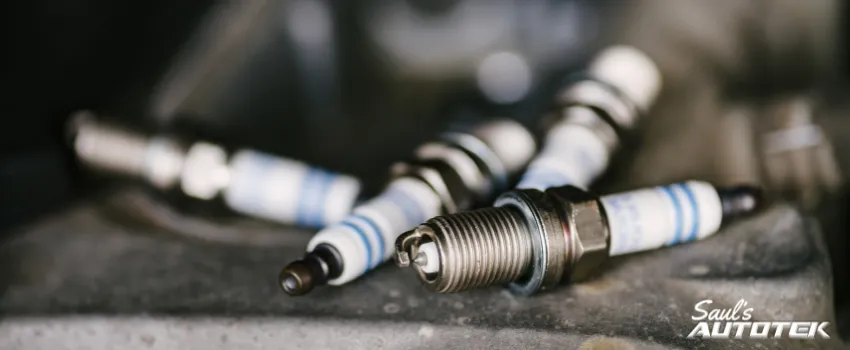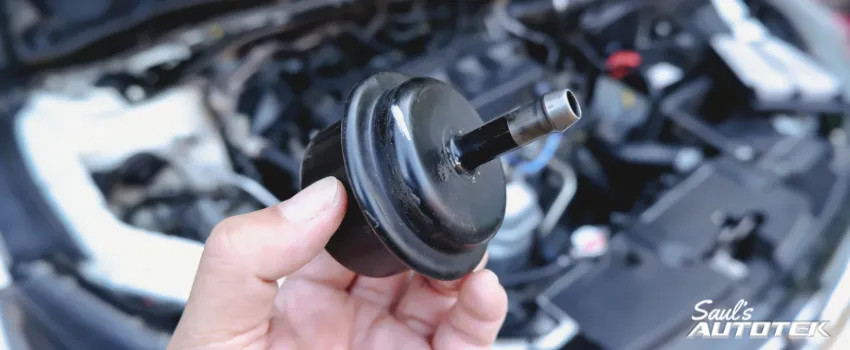Good morning, I’m Saul here at Saul’s AUTOTEK, and today we’re going to talk about timing chains.
Now this is an internal engine component that most people will never think about in terms of their vehicle, because you’re never going to see it, you’ll probably never hear it, and if you do it’s probably too late to actually save it from serious damage.
One thing you always hear mechanics talk about is getting your oil changes done appropriately, and at the right frequency. A lot of the newer modern vehicles will tell you that you can stretch that limit a little further, they recommend 3, 5, 7, or even 10,000 miles between oil changes. The reality is, using the proper grade of oil and doing your oil changes at the right intervals is extremely important for the longevity of your car. While going a few hundred miles over might not seem like a big deal at the moment because there’s no immediate empirical data that you are seeing of an issue, further damage can occur inside the engine, and we’re going to give you a quick look about how that happens, why, and how we can prevent it.
Today we have a 2007 Mazda CX-7 being serviced. The engine in this vehicle is used in many Ford and Mazda vehicles, whether it be a Taurus, a Fusion, a CX-7, a CX-9, Mazda 3, Mazda 6, and several others. So this may apply to multiple different vehicles across. The engine in this vehicle is a four-cylinder, 2.3 liter, turbocharged engine. Now Ford originally designed this engine all the way back in the ’70s in the original fuel crisis to put into a Mustang. Mazda’s partnership with Ford over the years led to the further development of this engine, and it became a racing engine used in a lot of the new Mazdaspeed vehicles. They also use it in several applications, such as this CX-7 that we have today.
Now the reason this vehicle’s here is, in its previous parts of life, it didn’t get its oil changes as often as it should. The owner came in and said their complaint was, when you started the car first thing in the morning, you hear a rattle noise for 5 to 10 seconds that would immediately go away. No lights, no codes, no other complaints of any kind in any way, shape, or form. Unfortunately, while it may seem like a small noise and a small issue, the reality of what’s happening is very, very serious and needs to be addressed immediately, or major engine components can fail.
To get access in this guy, the actual design is similar to that of a bicycle, where you ride the bike and the chain would go front to rear on the sprockets. Just like riding a bike and having that chain come off the sprockets, you’ve got to get off the bike, flip it over, put the chain back on, line the sprockets up, hold the tensioner and the derailleur, get everything set. That’s the same process that happens with the vehicle. However, unlike a bike where your feet come off the pedals so the chain comes off, you might just spin quick for a second, in a motor vehicle that could mean valves hit pistons and cause serious, serious engine damage.
In this Mazda CX-7, we’re replacing the timing chain, the guides that hold it smooth, and the tensioner that holds it tight, because the chain has stretched from not being properly lubricated. When oil change intervals weren’t done appropriately, the timing chain wasn’t lubricated and allowed it to elongate over time. Now, because so much lack of lubrication has occurred, when the engine starts first thing in the morning and all the oil’s in the bottom, we can actually hear the stretched out chain hitting the housing, making a grinding noise for a few seconds before that oil pressure builds up to hold that tensioner tight and hold that chain snug.
To show you just how invasive this job is, we’ve ripped this car down and got it prepped to the point of repair. Now to start with, when we come over to the vehicle, we have to remove everything that sits on top of the engine. Now we’ve got this guy bare and we can see our camshaft sitting up top, and we’re just using a couple of crescent wrenches just for added security, in addition to a factory holding tool to make sure nothing spins while we’re shooting our video here today.
In order to get access to the topside, we have to remove everything you see here on the ground. Which means pulling off the intercooler, the shrouding on it, the valve cover, the ignition coils and spark plugs, to get to the top. And then access this front timing cover, which surrounds that chain. We have to physically remove the motor mount from the vehicle, we must support the engine from underneath, so the vehicle is lifted in the air and supported by tooling from both sides to literally float that motor up in the air. Now this timing chain cover hasn’t been damaged by the stretched chain. We did find marks on the inside where the chain had been striking, but the cover itself will survive. As for the chain itself, much different story.
We take look into the engine bay of the vehicle. We can see our two camshafts where this chain would ride. This chain would ride straight across, straight down to the bottom, and right back up. We’ve removed the chain and went ahead and marked and pointed out where our connections are, so that we’ll be able to reference this guy as it comes back together. The chain itself, we wanted to show you exactly what kind of issues we look for.
We’ve got our chain pulled apart, and on the chain, we can actually hold it sideways and measure how much deflection we have between the links. There should be no deflection. There’s so much play in the rollers that just like a weak chainsaw, we can physically move between the joints substantially. What this translates to, is when this is spinning on the engine, it can physically shake side to side.
Give us a call here at Saul’s at (303) 919-7769. Stay smooth.
Schedule Your FREE diagnostic Subaru Outback Auto Repair Upkeep and Repair Appointment
Check out Our Reviews On Yelp! And Leave A Great One For Us!
Join Our Conversation on Facebook
Explore Our Exceptional Denver Auto Repair Services
- Brake Repair Service
- Suspension Repair
- Steering Repair
- Engine Repair
- Automotive Air Conditioning and Heating Repair





